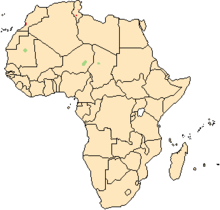
Back مهاة أبو عدس Arabic مها ابو عدس ARZ Аддакс AV Putcungol (Addax) AVK Addaks Azerbaijani Аддакс Byelorussian Адакс Bulgarian Adaks Breton Addax Catalan Addax nasomaculatus CEB
| Addax | |
|---|---|

| |
| An addax in Morocco | |
| Scientific classification | |
| Domain: | Eukaryota |
| Kingdom: | Animalia |
| Phylum: | Chordata |
| Class: | Mammalia |
| Order: | Artiodactyla |
| Family: | Bovidae |
| Subfamily: | Hippotraginae |
| Genus: | Addax Laurillard, 1841 |
| Species: | A. nasomaculatus
|
| Binomial name | |
| Addax nasomaculatus (Blainville, 1816)[3]
| |

| |
| Distribution of addax (IUCN 2015) Extant (resident)
Reintroduced
| |
| Synonyms | |
| |

The addax (Addax nasomaculatus), also known as the white antelope and the screwhorn antelope, is an antelope native to the Sahara Desert. The only member of the genus Addax, it was first described scientifically by Henri de Blainville in 1816. As suggested by its alternative name, the pale antelope has long, twisted horns – typically 55 to 80 cm (22 to 31 in) in females and 70 to 85 cm (28 to 33 in) in males. Males stand from 105 to 115 cm (41 to 45 in) at the shoulder, with females at 95 to 110 cm (37 to 43 in). They are sexually dimorphic, as the females are smaller than the males. The colour of the coat depends on the season – in the winter, it is greyish-brown with white hindquarters and legs, and long, brown hair on the head, neck, and shoulders; in the summer, the coat turns almost completely white or sandy blonde.
The addax mainly eats grasses and leaves of any available shrubs, leguminous herbs and bushes. They are well-adapted to exist in their desert habitat, as they can live without water for long periods of time. Addax form herds of five to 20 members, consisting of both males and females. The herd usually led by one dominant male.[5] Due to its slow movements, the addax is an easy target for its predators: humans, lions, leopards, cheetahs and African wild dogs. Breeding season is at its peak during winter and early spring. The natural habitat of the addax are arid regions, semideserts and sandy and stony deserts.
The addax is a critically endangered species of antelope, as classified by the IUCN. Although extremely rare in its native habitat due to unregulated hunting, it is quite common in captivity. The addax was once abundant in North Africa; however it is currently only native to Chad, Mauritania, and Niger. It is extirpated from Algeria, Egypt, Libya, Sudan, and Western Sahara, but has been reintroduced into Morocco and Tunisia.
- ^ IUCN SSC Antelope Specialist Group (2016). "Addax nasomaculatus". IUCN Red List of Threatened Species. 2016: e.T512A50180603. doi:10.2305/IUCN.UK.2016-2.RLTS.T512A50180603.en. Retrieved 3 June 2021.
- ^ "Appendices | CITES". cites.org. Retrieved 14 January 2022.
- ^ a b Wilson, D. E.; Reeder, D. M., eds. (2005). Mammal Species of the World: A Taxonomic and Geographic Reference (3rd ed.). Johns Hopkins University Press. p. 717. ISBN 978-0-8018-8221-0. OCLC 62265494.
- ^ Cite error: The named reference
Krausman2007was invoked but never defined (see the help page). - ^ "Addax". Smithsonian's National Zoo and Conservation Biology Institute. Retrieved 16 August 2024.
